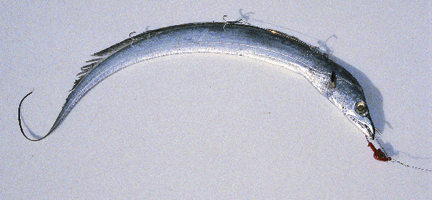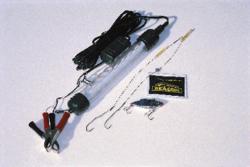Wrangling ribbonfish
Save a few bucks by catching your own kingfish bait

Catching live bait usually means that fun is right around the corner for kingfish anglers. However, with ribbonfish, the fun starts long before you head offshore.
For most, ribbonfish are flat, frozen baitfish that you unwrap, thaw and load up with stinger hooks. For those who fancy gathering fresh ribbons, however, the lively, lanky baits can provide as much sport as the kingfish they’ll someday tempt.
Officially named Atlantic cutlassfish and known colloquially as “silver eels,” ribbonfish are a ghoulish lot with slender, bladelike bodies, narrow heads loaded with formidable teeth and an aggressive nature rivaling that of the predators for which they are prey. Ribbonfish often turn up in cast nets, usually thrown for menhaden, but bait-seeking anglers capitalize on their ferocity by employing hook-and-line tactics that are as fun as they are effective.
The biggest concern with the aggressive ribbonfish is its menacing choppers, which make short work of monofilament. Long-shank 2/0 hooks will suffice, but adding 6 inches of No. 3 wire will minimize bite-offs. Pre-made wire rigs with barrel swivels for attaching main line and snap swivels for hanging hooks work fine. Fish these rigs on medium-action 6 1/2- to 7-foot spinning outfits with 8- to 20-pound main line and 30- or 40-pound monofilament leaders.
Look for ribbonfish in estuaries, commercial and cruise ports and anywhere you find deep water with muddy bottoms. Ribbons prey on smaller schooling baits, and anglers often find them by watching for slender, silver figures leaping across the surface. Cunning predators, ribbonfish will corral baits next to piers, jetties and seawalls, so keep watch near structure. When the fish don’t show, probe the area with chrome or blue Rat-L-Traps to locate your quarry.
 Helpful for ribbonfish location is a fluorescent light tube connected to your boat’s main battery, via alligator clips and hung from the stern. The light attracts small forage fish, which in turn draw in the ribbons. Once you’ve located the fish, toss out your rigs baited with thumbnail-size chunks of fresh shrimp, mullet or previously caught ribbonfish. These opportunistic and often cannibalistic hunters quickly sniff out the chow, but clipping mini light tubes to hook shanks increases visibility in dark water.
Helpful for ribbonfish location is a fluorescent light tube connected to your boat’s main battery, via alligator clips and hung from the stern. The light attracts small forage fish, which in turn draw in the ribbons. Once you’ve located the fish, toss out your rigs baited with thumbnail-size chunks of fresh shrimp, mullet or previously caught ribbonfish. These opportunistic and often cannibalistic hunters quickly sniff out the chow, but clipping mini light tubes to hook shanks increases visibility in dark water.
After a productive night of ribbonfish angling, conclude by preparing your baits for freezing and storage. Start by mixing a brining solution, which toughens the baits for freezing and prevents them from turning to mush when thawed.
In a large cooler, combine two 1-pound boxes of baking soda, three 3-pound boxes of coarse Kosher salt (not iodized) with a 5-gallon bucket of seawater and an 8-pound bag of ice. Fill the brining solution to just above the cooler’s drain plug and periodically add ice to maintain a chilly slush. Don’t overdo it, as too much ice will form a solid sheet over the baits and prevent brining.
Leave the ribbonfish in the brine for 8-12 hours – any longer and the solution will damage baits. You can cover the baits in plastic wrap overlaid with aluminum foil, but vacuum-sealed food storage sleeves yield optimal results. If you freeze two ribbons per sleeve, leave about an inch of space between them for thorough freezing.
When it’s time to thaw ribbonfish for rigging, just lay them on the deck for a few minutes. You’ll find it’s easier to rig a firm bait than one that’s completely softened, so don’t rush the thawing process by soaking your baits in warm water.